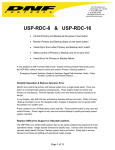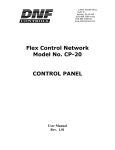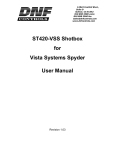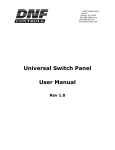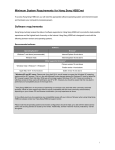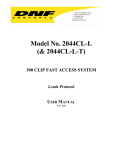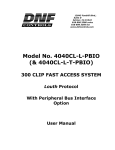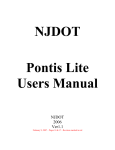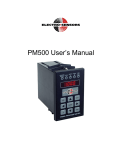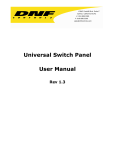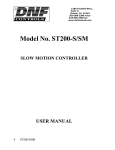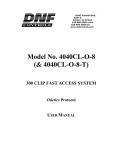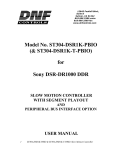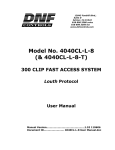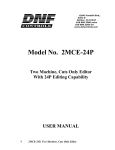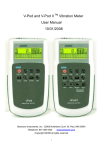Download CP20 Rev 2 User Manual
Transcript
12843 Foothill Blvd. Suite C Sylmar, California 91342 V: 818.898.3380 F: 818.898.3360 [email protected] Flex Control Network® Model No. CP-20 CONTROL PANEL User Manual Rev. 1.06 Table of Content Revision History....................................................................................................... 3 1. Installation.................................................................................................... 4 Connection Diagram ....................................................................................... 4 2. IP Configuration ............................................................................................. 5 A. IP Address Setup ..................................................................................... 5 B. Subnet Mask Setup .................................................................................. 5 C. Gateway Address Setup............................................................................ 5 3. Initial Setup .................................................................................................. 6 A. Set Password .......................................................................................... 7 B. Set System Time ..................................................................................... 8 C. Set System Label .................................................................................... 9 D. Set DNF Port Number ..............................................................................10 E. Set Ethernet Speed.................................................................................11 F. Channel Assignment ...............................................................................12 G. Additional Setups ...................................................................................13 H. System maintenance ...........................................................................14 4. Setup menu. .............................................................................................. 17 5. VTR mode ................................................................................................... 22 A. Play ......................................................................................................22 B. Recue ...................................................................................................22 C. Mark a Cue point ....................................................................................22 D. Learn Cue point......................................................................................23 E. Gang-Temporary (set in menu) ................................................................24 F. Gang-Permanent (set in menu) ................................................................24 G. Set IN and OUT points.............................................................................24 H. Load a Cue Point .................................................................................25 I. Recue ...................................................................................................26 J. Search to ..............................................................................................26 K. Preroll...................................................................................................26 6. CLIP mode .................................................................................................. 27 A. Load a clip.............................................................................................27 B. Play a clip..............................................................................................27 C. Recue ...................................................................................................27 D. Loop .....................................................................................................28 E. Play to Loop...........................................................................................28 F. Mark a Cue point ....................................................................................29 G. Learn a Cue point ...................................................................................29 H. Gang-Temporary (set in menu) .............................................................30 I. Gang-Permanent (set in menu) ................................................................30 J. Set IN and OUT points.............................................................................30 K. Load a Cue Point ....................................................................................31 L. Recue ...................................................................................................31 M. Search to ...........................................................................................31 N. Preroll ...............................................................................................32 O. Create a clip .......................................................................................32 7. Shotbox Functions........................................................................................ 33 8. Shotbox Shotkey Mapping of Cue Point Locations.............................................. 33 9. Function Table ............................................................................................. 34 10. Specifications .............................................................................................. 36 11. Keyboard layout........................................................................................... 37 DNF Controls Limited Warranty ................................................................................ 38 Flex Control Network®, CP20 User Manual Page 1 of 42 Flex Control Network®, CP20 User Manual Page 2 of 42 Revision History 020107 1.00 Original document. 020507 1.01 Minor corrections. 091207 1.02 Added new features (channel view, gang function). 091907 1.03 Minor corrections. 072709 1.04 Minor corrections. 081309 1.05 Added IP Configuration. 102510 1.06 Added Shotbox Document name ............................................................. CP20_User_Manual.doc Flex Control Network®, CP20 User Manual Page 3 of 42 1. Installation CAUTION Do NOT apply AC voltage to the power supply, before connecting the power supply to CP20 CONTROL PANEL. Component damage may occur. 1) Connect a Cat 5 cable to CP20 CONTROL PANEL connector labeled “E-NET #1”. Connect other end of the Cat 5 cable to customer supplied Ethernet hub. 2) Connect power supply DB9 female connector to the CP20 CONTROL PANEL connector labeled “POWER“. 3) Connect female side of AC power cable to the supplied power supply. 4) Connect male side of AC power cable to 100 – 240VAC. 5) Push the CONTROL PANEL power switch, located on rear panel, to ON position. “O” on the power switch is the OFF position. 6) When power up and system initialization completes, the front panel display will show Model Number and Software Version. Allow 25 seconds for power up and system initialization to complete. 7) OPTIONAL: Connect PC Keyboard to CP20 CONTROL PANEL connector labeled “Keyboard” 8) OPTIONAL: Connect ST420 Shotbox to CP20 CONTROL PANEL connector labeled “RS-232 Port” using the supplied RS232 cable. Use the top connector. CAUTION Do NOT apply AC voltage to power supply, then hot plug the power supply to the CP20 CONTROL PANEL. Component damage may occur. Connection Diagram Flex Control Network®, CP20 User Manual Page 4 of 42 2. IP Configuration IP Configuration is required after initial installation. A. IP Address Setup 1) On the CP20 front panel, press [Menu] to enter the setup menu. 2) Using the shuttle wheel, scroll to the left until the “Current IP Address” screen is displayed. Display will show current IP address. 3) Press {New IP} to edit the current IP address. 4) Using the numeric keypad, enter the desired IP address for the CP20. 5) Press {SAVE} to save new IP address. Confirmation will be requested before saving changes. Press {YES} to save the changes, or {NO} to discard them. OR Press {CANCEL} to exit without saving. NOTE- New IP Address will take effect on next power up. B. Subnet Mask Setup 1) On the CP20 front panel, press [Menu] to enter the setup menu. 2) Using the shuttle wheel, scroll to the left until the “Current Subnet Mask” screen is displayed. Display will show current subnet mask. 3) Press {New Subnet Mask} to edit the current IP address. 4) Using the numeric keypad, enter the desired subnet mask for the CP20. 5) Press {SAVE} to save new subnet mask. Confirmation will be requested before saving changes. Press {YES} to save the changes, or {NO} to discard them. OR Press {CANCEL} to exit without saving. NOTE- New Subnet Mask will take effect on next power up. C. Gateway Address Setup 1) On the CP20 front panel, press [Menu] to enter the setup menu. 2) Using the shuttle wheel, scroll to the left until the “Current Gateway” screen is displayed. Display will show current gateway. 3) Press {New Gateway} to edit the current IP address. 4) Using the numeric keypad, enter the desired gateway for the CP20. 5) Press {SAVE} to save new gateway. Confirmation will be requested before saving changes. Press {YES} to save the changes, or {NO} to discard them. OR Press {CANCEL} to exit without saving. NOTE- New Gateway Address will take effect on next power up. Flex Control Network®, CP20 User Manual Page 5 of 42 3. Initial Setup Setup is required after installation. This step may be performed at any other time, as required. Setup is performed using a computer running an off-the-shelf web browser such as “Microsoft Internet Explorer” or “Netscape”. Connect the CAT5 cable from the computer to the same Ethernet hub that the CP20 is connected to. After launching the web browser, enter the IP address of the CP20 to be setup. The Home Page will be displayed. Flex Control Network®, CP20 User Manual Page 6 of 42 A. Set Password The default password, when shipped from the factory, is “controls”, all lower case. The password is used to access all configuration screens. Using the web browser1) From the Home Page, click on the “System” link. The System page will be displayed. 2) Click on “Set Password”. The Set Password page will be displayed. 3) In the “Old password” entry box, enter the current password. Note- When shipped from the factory, the default password is “controls”, all lower case. 4) Enter the new password in the “New Password” entry box. 5) Enter the new password in the “Verify New Password” entry box. 6) Click on “Save” to save the new password. OR Click on “Cancel” to exit without changing the password. NoteIf the “New Password” entry and the “Verify New Password” entry do not match, an error will be displayed. Flex Control Network®, CP20 User Manual Page 7 of 42 B. Set System Time The system time is only used for error and event time stamping. Using the web browser1) From the Home Page, click on the “System” link. The System page will be displayed. 2) Click on “Set System Time”. The Set System Time page will be displayed. 3) Using the drop down menus, set the current date and time. 4) Click on “Save” to save the entered date and time. OR Click on “Cancel” to exit without saving. Flex Control Network®, CP20 User Manual Page 8 of 42 C. Set System Label The System Label is used to uniquely identify a CP20. This name is associated with the IP address. Using the web browser1) From the Home Page, click on the “System” link. The System page will be displayed. 2) Click on “Set System Label”. The Set System Label page will be displayed. 3) Enter any name made up of letters, numbers, or special characters, up to 16 characters. 4) Click on “Save” to save the entered name. OR Click on “Cancel” to exiting without changing the System Label. Flex Control Network®, CP20 User Manual Page 9 of 42 D. Set DNF Port Number The DNF Port Number is only changed from it default value (50000) when required to pass through customer firewalls. Please consult your IT department for a port number value. This setting must match the Port Number setting on all Flex Control Network units that this product will connect to. Using the web browser1) From the Home Page, click on the “System” link. The System page will be displayed. 2) Click on “Set DNF Port Number”. The Set DNF Port Number page will be displayed. 3) Enter a valid number corresponding to the current system. 4) Click on “Save” to save the entered DNF port number. OR Click on “Back” to exit without saving. Flex Control Network®, CP20 User Manual Page 10 of 42 E. Set Ethernet Speed The default password, when shipped from the factory, is “controls”, all lower case. The password is used to access all configuration screens. Using the web browser1) From the Home Page, click on the “System” link. The System page will be displayed. 2) Click on “System Maintenance” Link, the System Maintenance page will be displayed. 3) Click on “Set Ethernet Speed” Link, the Ethernet Speed Setting page will be displayed. 4) Click on the Radio button to select the Ethernet speed, and then click on the Apply button. OR Click on the Back button to exit without making any changes. Flex Control Network®, CP20 User Manual Page 11 of 42 F. Channel Assignment The Channel Assignment Table Setup is performed using a computer running an off-the-shelf web browser such as “Microsoft Internet Explorer” or “Netscape”. Connect the CAT5 cable from the computer to the same Ethernet hub that the CONTROL PANEL is connected to. After launching the web browser, enter the IP address of the CP20 to be setup. The Home Page will be displayed. 1) Click on the “Channel Assignment” link at the top of the page. The Channel Assignment Table will be displayed. 2) Flex Control Network®, CP20 User Manual Page 12 of 42 3) Click on the “Edit Channel Assignment Table” link at the bottom of the page. The Edit Channel Assignment Table will be displayed. 4) Click in the Remote IP address field and enter the IP address of the DC20 device controller. Click on the arrow of the dropdown box and select the remote channel to be connected. 5) Repeat the previous step for each VTR channel. 6) At the bottom of the table enter the IP address for the primary and backup CUE SERVER (DC20). 7) If used, in the PBIO field, enter the IP address of the DC20 to which the production switcher is attached. 8) Click on “Save” to save the entered data. OR Click on “Back” to exit without saving. G. Additional Setups No additional setups are required in “System Maintenance” for normal operation. Flex Control Network®, CP20 User Manual Page 13 of 42 H. System maintenance View event logs The default password, when shipped from the factory, is “controls”, all lower case. The password is used to access all configuration screens. Using the web browser1) From the Home Page, click on the “System” link. The System page will be displayed. 2) Click on “System Maintenance” Link, the System Maintenance page will be displayed. 3) Click on “View Event Logs” Link, the Event Logs File List page will be displayed. Flex Control Network®, CP20 User Manual Page 14 of 42 4) Click on a radio button to select the Event File to view. Then click on the “View Log” button to display the file. 5) Right click on the file name to “Save As” the file to the PC. The file will be saved as a standard “CSV” (coma separated value) format. 6) Click on the Back button to exit the page. Flex Control Network®, CP20 User Manual Page 15 of 42 View System Logs The default password, when shipped from the factory, is “controls”, all lower case. The password is used to access all configuration screens. Using the web browser1) From the Home Page, click on the “System” link. The System page will be displayed. 2) Click on “System Maintenance” Link, the System Maintenance page will be displayed. 3) Click on “View System Logs” Link, the System Logs File List page will be displayed. 4) Double click on the file name to view the file. 5) Right click on the file name to “Save As” the file to the PC. 6) Click on any menu link to exit the View Page Mode. 7) Click on the radio button to select the file for deletion. Then click the Delete button to delete the selected file. 8) Click on the Back button to exit without deleting the file. System Snapshot The default password, when shipped from the factory, is “controls”, all lower case. The password is used to access all configuration screens. Using the web browser1) From the Home Page, click on the “System” link. The System page will be displayed. 2) Click on “System Maintenance” Link, the System Maintenance page will be displayed. 3) Click on “System Snapshot” Link, the View System Snapshot page will be displayed. 4) Click the “Display on Screen” radio button or “Send to File” radio button Then click on the submit button to perform the selected function. The snapshot will show the system configuration. This is primarily for diagnostic purposes. Flex Control Network®, CP20 User Manual Page 16 of 42 4. Setup menu. Press the [MENU] key and turn the wheel clockwise to select the setup item. Then press a {Softkey} to choose the option or use the Keypad to enter a value. Press Softkey or {VTR}: To reassign channel #: Turn the wheel Press {<-} or {->} to view available devices. Press {SEL} to assign device to channel #1. To GANG all available channels: Press {GANG} to gang all available channels to channels. Status is from device assigned to channel #1. Press [MENU], then {VTR}, then {UNGANG} to release the gang function. Turn wheel to make other menu selections. VERSION NUMBER Shows model number and Software version number. SYSTEM LABEL This field shows the control panel name assigned through the browser application. REC: {LOCKOUT}: Record function is disabled. CRASH: Record function will use CRASH MODE for recording. {ASSEMBLE}: Record function will use ASSEMBLE MODE for recording (not available on all protocols). {INSERT}: Record function will use INSERT MODE for recording (not available on all protocols). WIND MODE: {LATCH}: The fast wind button function will remain active until another motion button is pressed. {HOLD}: The fast wind button function will cease as soon as the fast wind button is released. {SPEED}: Press softkey to set the maximum fast wind speed. SYSTEM ID: Not changeable ` Select LOCAL or GLOBAL then press the {YES} key to clear all CUE points on the selected unit. Press the {NO} key to not clear the CUE points. GET GLOBAL CUES Select {GET} to Pull GLOBAL CUE LIST from Cue List. Flex Control Network®, CP20 User Manual Page 17 of 42 MARK CUE: {CURRENT}: The cue data will be saved in the current cue point location. {ADVANCE}: The cue point number will increment by one and then the cue data will be saved in the cue point number location. MARK: Select the TIME DATA to save into the cue point. {IN and OUT}: Save IN and OUT points into the cue point. {CURRENT}: Save only the CURRENT time into the cue point. Do NOT save the IN and OUT points in the cue point. MARK KEY: {MARK}: To save only the time CURRENT into the cue point {LEARN}: To save IN/OUT points and GANG DATA into the cue point. (NOTE- Press SHIFT + MARK to execute the alternate function) LOAD KEY: Select LOAD key mode{GOTO}: Only the SELECTED CHANNEL'S cue point data will be loaded. This mode does NOT restore the gang configuration. {RECALL}: The cue point data will load on all channels that were part of the original Learn. This mode will restore the Learned gang configuration. {REDIRECT}: Load the cue point data for Channels 1 and 2 on the selected channel pair- {1,2}, {3,4}, {5,6}, or {7,8}. Follow the prompt on the LCD display. (NOTE- Press SHIFT + LOAD to execute the alternate function) GANG: Select GANG mode. {TEMPORARY}: Gang Channels by pressing and holding one [Channel] key, then press and release other [Channel] keys to add to the gang. Release all [Channel] keys when done. Press any [Channel] key to cancel the gang. {PERMANENT}: Press and hold [SHIFT] and then press any [Channel] key. Release [SHIFT]. Follow the prompts on the LCD display. Press a [Channel] key to add it to the gang. Press the [Channel] key again to remove it from the gang. Press [SHIFT] when done. The gang will remain until cancelled by pressing [SHIFT] + any [Channel] key. Flex Control Network®, CP20 User Manual Page 18 of 42 IP ADDRESS DISPLAY: {ON}: Show IP address on LCD display {OFF}: Do NOT show IP address on LCD display (recommended) REC KEY: {REC}: Press only the REC key to start record. {REC + PLAY}: Press and hold REC and then press PLAY to start record. PREROLL Press the [Channel] key and then press {CHANGE}. Use the numeric keypad to enter the new value. Press [ENTER] to save the new value. Each Channel has its own PREROLL value. POSTROLL For CAPTURE Function only. Set amount of postroll past OUT point. Press the [Channel] key and then press {CHANGE}. Use the numeric keypad to enter the new value. Press [ENTER] to save the new value. Each Channel has its own POSTROLL value. FAT-IN For CAPTURE Function only. Set amount of record pad before IN point. Press the [Channel] key and then press {CHANGE}. Use the numeric keypad to enter the new value. Press [ENTER] to save the new value. Each Channel has its own FAT-IN value. FAT-OUT For CAPTURE Function only. Set amount of record pad after OUT point. Press the [Channel] key and then press {CHANGE}. Use the numeric keypad to enter the new value. Press [ENTER] to save the new value. Each Channel has its own FAT-OUT value. GANG SYNC: Used to GANG devices located on multiple DC20 Device Controllers. {No LTC + Ref Video}: GANG play and record will NOT be frame accurate across devices connected to different DC20s. {With LTC + Ref Video}: GANG play and record will be frame accurate across devices connected to different DC20s. NETWORK DELAY: Only required when doing frame accurate GANG Play across devices connected to different DC20s. Please contact DNF Customer Support prior to changing. GANG NETWORK DELAY: View the network delay of each ganged channel. Flex Control Network®, CP20 User Manual Page 19 of 42 CURRENT IP ADDRESS: View current IP Address. Press softkey to change the displayed address. Use keypad to enter new address. The system must be rebooted for the new setting to take effect. CURRENT SUBNET MASK: View current Subnet Mask. Press softkey to change the displayed mask address. Use keypad to enter new address. The system must be rebooted for the new setting to take effect. CURRENT GATEWAY: View current Gateway. Press softkey to change the displayed gateway address. Use keypad to enter new address. The system must be rebooted for the new setting to take effect. CHANNEL: Assign devices to the CP20 channel keys. Press {<-} or {->} keys to select the CP20 channel. Press {EDIT} Then: Press {IP} to select DC20, use keypad to enter IP address. Use {<-} or {->} to position cursor on IP address field. Press {CH} to select DC20 device port number. Use keypad to enter Channel number. Press {SAVE} to assign device to CP20 channel. Press {UP} to return to CHANNEL assignment menu. Press {LBL} to list all available devices. Turn wheel to select device then press [ENTER] to assign device to CP20 channel. CHANNEL ASSIGNMENT TABLE: {BACKUP}: Save the current Channel Assignments to a file. Enter a file name using the numeric keypad. Or, turn the wheel to select and overwrite an existing file. Press [ENTER] to complete the save. {RESTORE}: Replace the current Channel Assignments with those saved in the selected file. Enter a file name using the numeric keypad. Or, turn the wheel to select an existing file. Press [ENTER] to restore the selected file. LTC SNAPSHOT: Diagnostic only. No LTC Signal: there is no LTC signal connected to the CP20. {REFRESH}: Press softkey to refresh the reading. Flex Control Network®, CP20 User Manual Page 20 of 42 TIME MODE: Select channel Press {TOGGLE} to set time mode. TM: Display elapsed time from first frame (always 00:00:00:00) of video. TC: Display Timecode. VT: Display vertical interval time code data Flex Control Network®, CP20 User Manual Page 21 of 42 5. VTR mode NOTE: TAPE MUST BE LOADED MANUALLY ON THE VTR. A. Play 1) OPTIONAL: a. Set an IN Point and OUT Point. b. Jog/Shuttle to the desired IN point. Press [IN]. c. Jog/Shuttle to the desired OUT point. Press [OUT]. OR d. Press [SHIFT] + [IN]. Manually enter the IN time on the numeric keypad. Press [ENTER]. e. Press [SHIFT] + [OUT]. Manually enter the OUT time on the numeric keypad. Press [ENTER]. 2) Press [PLAY]. The tape will play from its current time to the OUT point, and then stop. If OUT point is not set then it will play to end of TAPE. B. Recue Press [GOTO]. The tape will cue to the IN point. If no in point is entered: will do nothing. C. Mark a Cue point NOTE: TAPE MUST BE LOADED MANUALLY ON THE VTR. With menu setting: MARK CUE=MARK. 1) Press VTR [1], [2], [3], [4], [5], [6], [7] or [8]. 2) OPTIONAL a. Use the transport functions to view the clip. b. Press [IN] to set an IN point. The IN LED will turn on. c. Press [OUT] to set an OUT point. The OUT LED will turn on. d. To delete an IN or OUT point, press and hold [DEL], then press [IN] or [OUT]. The IN/OUT LED will turn off. e. If no IN point is set, the current location of the clip will be SET as the IN point. 3) Select the desired Cue Point by pressing [NEXT], [LAST] or by manually entering the Cue Point using the numeric keypad, followed by [ENTER]. The selected Cue Point number is shown on the bottom part of the display. 4) Press [MARK] to create the Cue point. NOTE: MARK will overwrite the previous contents of the Cue Point. 5) Press [ESC] at anytime to escape without MARKing. Flex Control Network®, CP20 User Manual Page 22 of 42 D. Learn Cue point With menu setting: MARK CUE=LEARN 1) Press VTR [1], [2], [3], [4], [5], [6], [7] or [8]. 2) OPTIONAL: a. Use the transport functions to view the clip. b. Press [IN] to set an IN point. The IN LED will turn on. On recall, the clip will cue to the IN time, not the beginning of the clip. c. Optional- Press [OUT] to set an OUT point. The OUT LED will turn on. On recall, the clip will play to the OUT point then stop. d. To delete an IN or OUT point, press and hold [DEL], then press [IN] or [OUT]. The IN/OUT LED will turn off. e. If no IN point is set, the current location of the clip will be learned as the IN point. f. For GANG, repeat steps a. through e. for each channel. Then, press the [SHIFT] + any [VTR] key enter the GANG mode. Press VTR [1], [2], [3], [4], [5], [6], [7] or [8] to add the VTR to the GANG. The VTR LED will turn on. Press the VTR key again to remove it from the gang. The VTR LED will turn off. Press [ENTER] to complete the GANG mode. The LED of all GANGed VTRs will turn on. The primary VTR's LED will flash. 3) Select the desired Cue Point by pressing [NEXT], [LAST] or by manually entering the Cue Point using the numeric keypad, followed by [ENTER]. The selected Cue Point number is shown on the bottom part of the display. 4) Press [MARK] to initiate the Learn. The display will show: “Select VTRs to learn: --------”. 5) Select the VTRs to be learned by pressing VTR keys [1], [2], [3], [4], [5], [6], [7] or [8], press the VTR key a second time to not include it as part of the LEARN. 6) Select the "play mode": a. {NORMAL}: Clip will play one time and stop. b. {2P}: Loop mode (plays from IN point to OUT point; Enter the number of plays before the loop mode is exited; press [ENTER] to complete the iteration count entry. c. {3P}: Play to Loop: (plays from beginning of clip to end or OUT point and loops to IN point and continues to loop between the IN point and OUT point; Enter the number of plays before the loop mode is exited; press [ENTER] to complete the iteration count entry. Flex Control Network®, CP20 User Manual Page 23 of 42 7) Press {LRN} or [MARK] to complete the Learn process. NOTE: Learn will overwrite the previous contents of the Cue Point. 8) Press [ESC] at anytime to escape without LEARNing. E. Gang-Temporary (set in menu) 1) Press all the VTR keys that are to be part of the Gang at the same time. The LEDs will light to indicate that they are part of the GANG. The flashing LED indicates the selected VTR. 2) Press any VTR key to cancel the GANG. F. Gang-Permanent (set in menu) 1) Press the [SHIFT] key + any [VTR] key to start the gang dialogue. 2) Press VTR [1], [2], [3], [4], [5], [6], [7] or [8] to add the VTR to the GANG. The VTR LED will turn on. Press the VTR key again to remove it from the gang. The VTR LED will turn off. 3) Press [SHIFT] to complete the GANG mode. The LEDs of all GANGed VTRs will turn on and the selected VTR LED will flash. 4) To CANCEL the gang function: Press the [SHIFT] key + any [VTR] key to start the gang dialogue. Press the {CLEAR} key to cancel the gang function. G. Set IN and OUT points 1) Set an IN Point and/or OUT Point. Jog/Shuttle to the desired IN Point. Press [IN]. Jog/Shuttle to the desired OUT Point. Press [OUT]. 2) Press [IN] to set an IN point. The IN LED will turn on. Optional- Press [OUT] to set an OUT point. The OUT LED will turn on. Press [SHIFT] + [IN]. Manually enter the IN time on the numeric keypad. Press [ENTER]. Press [SHIFT] + [OUT]. Manually enter the OUT time on the numeric keypad. Press [ENTER]. 3) To delete an IN or OUT point, press and hold [DEL], then press [IN] or [OUT]. The IN/OUT LED will turn off. Flex Control Network®, CP20 User Manual Page 24 of 42 H. Load a Cue Point LOAD KEY = LOAD 1) Press [NEXT] or [LAST] key or enter cue number and press [ENTER] on the keypad 2) Press the [LOAD] key. The VTR will be cued to the set in point. OR If the Cue was saved as a "LEARN" then: Press [SHIFT] + [LOAD] key. All the VTRs that were learned will be loaded and cued to their in points as well as the learned GANG states. LOAD KEY = RECALL 1) Press [NEXT] or [LAST] key or enter cue number and press [ENTER] on the keypad 2) Press the [LOAD] key. All the VTRs that were learned will be loaded and cued to their in points as well as the learned GANG states. OR If the Cue was saved as a "MARK" then: Press [SHIFT] + [LOAD] key. The VTR will be cued to the set in point. LOAD KEY = REDIRECT 1) Press [NEXT] or [LAST] key or enter cue number and press [ENTER] on the keypad 2) Press the [LOAD] key. 3) The screen will display softkeys to select the alternate pairs of VTR channels {1,2}; {3,4}; {5,6}; {7,8} to which to load the CUE POINT. The VTRs will be loaded from channels 1 & 2 to the selected pair of channels and cued to the set in point. OR If the Cue was saved as a "LEARN" then: 1) Press [SHIFT] + [LOAD] key. (All the VTRs that were learned will be loaded and cued to their in points as well as the learned GANG states). 2) The screen will display softkeys to select the alternate pairs of VTR channels: {1,2}; {3,4}; {5,6}; {7,8} to which to load the CUE POINT. The VTRs will be loaded from channels 1 & 2 to the selected pair of channels and cued to the set in point. 3) All the VTRs that were learned will be loaded and cued to their in points as well as the learned GANG states. Flex Control Network®, CP20 User Manual Page 25 of 42 I. Recue Press [GOTO]. If an IN Point is set (the IN indicator is on), the VTR will RECUE to the IN Point. If no IN point is set then do nothing. J. Search to 1) Press [SHIFT] + [GOTO] then enter the search point on the keypad and press [ENTER] to cue to the entered time. 2) Press [SHIFT] + [IN] then [GOTO] will cue to the in point. 3) Press [SHIFT] + [OUT] then [GOTO] will cue to the out point. K. Preroll Press [PREROLL] to cue to the amount of time preset in the menu before the current position. If an IN point was set it will cue to the preset amount before the in point. Flex Control Network®, CP20 User Manual Page 26 of 42 6. CLIP mode A. Load a clip 1) Select a VTR by pressing VTR [1], [2], [3], [4], [5], [6], [7] or [8]. 2) Press [CLIP LIST] to view the list of CLIP IDs that are resident on the Video Server. The CLIP LIST indicator will turn on. Turn the Wheel clockwise to scroll forward, or counter-clockwise to scroll backward, through the list of available CLIPs. Backward scrolling is limited to the last 10 screens of CLIP IDs viewed. OR Manually enter a CLIP ID using the CP20 numeric keypad, or PC keyboard. 3) Press [LOAD] to load the entered CLIP ID for playout. 4) Repeat steps 1) thru 3) to load clips on other VTRs. 5) Set the Gang Mode, if required. See “GANG SETUP” in “FUNCTION TABLE” section. B. Play a clip 1) OPTIONAL: a. Set an IN Point and OUT Point. b. Jog/Shuttle to the desired IN point. Press [IN]. c. Jog/Shuttle to the desired OUT point. Press [OUT]. OR d. Press [SHIFT] + [IN]. Manually enter the IN time on the numeric keypad. Press [ENTER]. e. Press [SHIFT] + [OUT]. Manually enter the OUT time on the numeric keypad. Press [ENTER].Press [PLAY]. The clip will play from its current time to the OUT point, and then stop. If OUT point is not set then it will play to end of clip. 2) Press [PLAY], the clip will play from its current position to the out point, and then stop. If out point is not set, then play to the end of the clip. C. Recue Press [GOTO]. The clip will cue to the IN point. If no IN point is set then cue to beginning of clip. Flex Control Network®, CP20 User Manual Page 27 of 42 D. Loop 1) Load the clip using LOAD A CLIP, or LOAD a cue point. 2) OPTIONAL: a. Set an IN Point and/or OUT Point. b. Jog/Shuttle to the desired IN Point. Press [IN]. c. Jog/Shuttle to the desired OUT Point. Press [OUT]. OR a. Press [SHIFT] + [IN]. Manually enter the IN time on the numeric keypad. Press [ENTER]. b. Press [SHIFT] + [OUT]. Manually enter the OUT time on the numeric keypad. Press [ENTER]. NOTE: To loop the whole clip, do not enter IN/OUT. 3) Press [LOOP ENABLE]. The clip will immediately start looping. NOTE: If the clip ID ends with an asterisk (“*”), it will automatically loop when [PLAY] is pressed. E. Play to Loop The PLAY TO LOOP function will start from the beginning of the clip play to the out point (or to the end of clip if out point is not set) and then loop to the in point and continue to loop between the in and the out points (or to the end of the clip if out point is not set). 1) Load the clip using LOAD A CLIP, or LOAD a Cue Point. 2) Set an IN Point and/or OUT Point. a. Jog/Shuttle to the desired IN Point. Press [IN]. b. Jog/Shuttle to the desired OUT Point. Press [OUT]. OR a. Press [SHIFT] + [IN]. Manually enter the IN time on the numeric keypad. Press [ENTER]. b. Press [SHIFT] + [OUT]. Manually enter the OUT time on the numeric keypad. Press [ENTER]. 3) Press [SHIFT] + [LOOP ENABLE]. The clip will immediately cue to beginning of the clip and the LOOP ENABLE LED will start blinking. 4) Press [PLAY] to start the PLAY TO LOOP. NOTE: If the clip ID ends with an asterisk (“#”), it will automatically perform A PLAY TO LOOP when [PLAY] is pressed. Flex Control Network®, CP20 User Manual Page 28 of 42 F. Mark a Cue point With menu setting: MARK CUE=MARK. 1) Press VTR [1], [2], [3], [4], [5], [6], [7] or [8]. 2) Load a clip on the selected channel. See section LOAD A CLIP. 3) OPTIONAL: a. Use the transport functions to view the clip. b. Press [IN] to set an IN point. The IN LED will turn on. On recall, the clip will cue to the IN time, not the beginning of the clip. c. Press [OUT] to set an OUT point. The OUT LED will turn on. On recall, the clip will play to the OUT point then stop. d. To delete an IN or OUT point, press and hold [DEL], then press [IN] or [OUT]. The IN/OUT LED will turn off. e. If no IN point is set, the current location of the clip will be MARKED as the IN point. 4) Select the desired Cue Point by pressing [NEXT], [LAST] or by manually entering the Cue Point using the numeric keypad, followed by [ENTER]. The selected Cue Point number is shown on the bottom part of the display. 5) Press [MARK] to create the Cue point. NOTE: Play mode is defaulted to "NORMAL" (no loop) for all MARKed cue points. MARK will overwrite the previous contents of the Cue Point. 6) Press [ESC] at anytime to escape without MARKing. G. Learn a Cue point With menu setting: MARK CUE=LEARN. 1) Press VTR [1], [2], [3], [4], [5], [6], [7] or [8]. 2) Load a clip on the selected channel. See section LOAD A CLIP 3) OPTIONAL: a. Use the transport functions to view the clip. b. Press [IN] to set an IN point. The IN LED will turn on. On recall, the clip will cue to the IN time, not the beginning of the clip. c. Optional- Press [OUT] to set an OUT point. The OUT LED will turn on. On recall, the clip will play to the OUT point then stop. To delete an IN or OUT point, press and hold [DEL], then press [IN] or [OUT]. The IN/OUT LED will turn off. If no IN point is set, the current location of the clip will be learned as the IN point. d. For GANG, repeat steps a. through c. for each channel. Then, press the [SHIFT] + any [VTR] key enter the GANG mode. e. Press VTR [1], [2], [3], [4], [5], [6], [7] or [8] to add the VTR to the GANG. The VTR LED will turn on. f. Press the VTR key again to remove it from the gang. The VTR LED will turn off. g. Press [ENTER] to complete the GANG mode. The LED of all GANGed VTRs will turn on. The primary VTR's LED will flash. 4) Select the desired Cue Point by pressing [NEXT], [LAST] or by manually entering the Cue Point using the numeric keypad, followed by [ENTER]. 5) The selected Cue Point number is shown on the bottom part of the display. 6) Press [MARK] to initiate the Learn. Flex Control Network®, CP20 User Manual Page 29 of 42 7) The display will show: “Select VTRs to learn: --------”. 8) Select the VTRs to be learned by pressing VTR keys [1], [2], [3], [4], [5], [6], [7] or [8], press the VTR key second time to not include it as part of the LEARN. 9) Select the "play mode": a. {NORMAL}: Clip will play one time and stop. b. {2P}: Loop mode (plays from IN point to OUT point; Enter the number of plays before the loop mode is exited; press [ENTER] to complete the iteration count entry. c. {3P}: Play to Loop: (plays from beginning of clip to end or OUT point and loops to IN point and continues to loop between the IN point and OUT point; Enter the number of plays before the loop mode is exited; press [ENTER] to complete the iteration count entry. 10) Press {LRN} or [MARK] to complete the Learn process. NOTE: Learn will overwrite the previous contents of the Cue Point. 11) Press [ESC] at anytime to escape without LEARNing. H. Gang-Temporary (set in menu) 1) Press all the VTR keys that are to be part of the Gang at the same time. The LEDs will light to indicate that they are part of the GANG. The flashing LED indicates the selected VTR. 2) Press any VTR key to cancel the GANG. I. Gang-Permanent (set in menu) 1) Press the [SHIFT] key + any [VTR] key to start the gang dialogue. 2) Press VTR [1], [2], [3], [4], [5], [6], [7] or [8] to add the VTR to the GANG. The VTR LED will turn on. Press the VTR key again to remove it from the gang. The VTR LED will turn off. 3) Press [SHIFT] to complete the GANG mode. The LEDs of all GANGed VTRs will turn on and the selected VTR LED will flash. To CANCEL the gang function: 4) Press the [SHIFT] key + any [VTR] key to start the gang dialogue. 5) Press the {CLEAR} key to cancel the gang function. J. Set IN and OUT points 1) Set an IN Point and/or OUT Point. Jog/Shuttle to the desired IN Point. Press [IN]. Jog/Shuttle to the desired OUT Point. Press [OUT]. 2) Press [IN] to set an IN point. The IN LED will turn on. On recall, the clip will cue to the IN time, not the beginning of the clip. 3) Optional- Press [OUT] to set an OUT point. The OUT LED will turn on. On recall, the clip will play to the OUT point then stop. OR a. Press [SHIFT] + [IN]. Manually enter the IN time on the numeric keypad. Press [ENTER]. b. Press [SHIFT] + [OUT]. Manually enter the OUT time on the numeric keypad. Press [ENTER]. To delete an IN or OUT point, press and hold [DEL], then press [IN] or [OUT]. The IN/OUT LED will turn off. Flex Control Network®, CP20 User Manual Page 30 of 42 K. Load a Cue Point LOAD KEY = LOAD 1) Press [NEXT] or [LAST] key or enter cue number and press [ENTER] on the keypad 2) Press the [LOAD] key. The clip will be cued to the set in point. OR 3) If the Cue was saved as a "LEARN" then: 4) Press [SHIFT] + [LOAD] key. All the VTRs that were learned will be loaded and cued to their in points as well as the learned GANG states. LOAD KEY = RECALL 1) Press [NEXT] or [LAST] key or enter cue number and press [ENTER] on the keypad 2) Press the [LOAD] key. All the VTRs that were learned will be loaded and cued to their in points as well as the learned GANG states. 3) OR 4) If the Cue was saved as a "MARK" then: 5) Press [SHIFT] + [LOAD] key. The clip will be cued to the set in point. LOAD KEY = REDIRECT 1) Press [NEXT] or [LAST] key or enter cue number and press [ENTER] on the keypad 2) Press the [LOAD] key. 3) The screen will display softkeys to select the alternate pairs of VTR channels: {1,2}; {3,4}; {5,6}; {7,8} to which to load the CUE POINT. The clips will be loaded from channels 1 & 2 to the selected pair of channels with the clip cued to the beginning of clip or to set in point. OR 4) If the Cue was saved as a "LEARN" then: 5) Press [SHIFT] + [LOAD] key. (All the VTRs that were learned will be loaded and cued to their in points as well as the learned GANG states). 6) The screen will display softkeys to select the alternate pairs of VTR channels: {1,2}; {3,4}; {5,6}; {7,8} to which to load the CUE POINT. The VTRs will be loaded from channels 1 & 2 to the selected pair of channels with the clip and cued to the beginning of clip or to set in point. 7) All the VTRs that were learned will be loaded and cued to their in points as well as the learned GANG states. L. Recue Press [GOTO]. If an IN Point is set (the IN indicator is on), the clip will RECUE to the IN Point. If the IN point is not set, the clip will RECUE to the start of the clip. M. Search to 1) Press [SHIFT] + [GOTO] then enter the search point on the keypad to cue to the entered time. 2) Press [SHIFT] + [IN] then [GOTO] will cue to the in point. 3) Press [SHIFT] + [OUT] then [GOTO] will cue to the out point. Flex Control Network®, CP20 User Manual Page 31 of 42 N. Preroll Press [PREROLL] to cue to the amount preset in the menu before the current position. If an in point was set it will then cue to the preset amount before the in point. O. Create a clip 1) Press [CLIP LIST]. 2) Press [CREATE]. 3) Manually enter an ID from the CP20 numeric keypad. OR Manually enter an ID from a PC keyboard. 4) Press [LOAD]. The clip will be created and loaded. If the entered CLIP ID already exists, a warning message will be displayed. 5) To load the existing clip, press [ENTER]. 6) Press [REC] or [REC] + [PLAY] keys to start the record process. OR 7) Press [ESC] to exit without loading the existing clip. Flex Control Network®, CP20 User Manual Page 32 of 42 7. Shotbox Functions NOTE: Using the ST420 Shotbox with the CP20 Control Panel requires the following software versions: CP20: V6.23A or later ST420: V4.14 102910 or later [PLAY]: Plays out the selected clip. [RECUE]: Returns to the beginning of the clip. [STOP]: Stops playout of the clip. [LEARN]: Press to initiate the shotbox learn function. [ESC]: Cancel an activated function. 8. Shotbox Shotkey Mapping of Cue Point Locations The Shotkeys on the Shotbox access the cue point locations in the CP20 as follows: BANK 0, Shotkeys 1 -> 30 access cue point locations 001 - 030. BANK 1, Shotkeys 1 -> 30 access cue point locations 101 - 130. BANK 2, Shotkeys 1 -> 30 access cue point locations 201 - 230. BANK 3, Shotkeys 1 -> 30 access cue point locations 301 - 330. BANK 4, Shotkeys 1 -> 30 access cue point locations 401 - 430. BANK 5, Shotkeys 1 -> 30 access cue point locations 501 - 530. BANK 6, Shotkeys 1 -> 30 access cue point locations 601 - 630. BANK 7, Shotkeys 1 -> 30 access cue point locations 701 - 730. BANK 8, Shotkeys 1 -> 30 access cue point locations 801 - 830. BANK 9, Shotkeys 1 -> 30 access cue point locations 901 - 930. Flex Control Network®, CP20 User Manual Page 33 of 42 9. Function Table Function Key Press Description CLIP LIST [CLIP LIST] Press the [CLIP LIST] key to access the clip list on the server. FFWD [FFWD] Press and HOLD to shuttle. Release key to stop. Set WIND Speed in MENU. GANG RE-SYNC [SHIFT] + [STOP] Press and hold the [SHIFT] key and press the [STOP] key. This will reestablish the time offset to the ganged channels. After multiple play/stop, jog or shuttle operations the offset between the ganged channels can be off by several frames. GANG SETUP [SHIFT] + [any VTR key] Individually press the VTR keys to be included in the gang. The LED above the key will turn on. Press the VTR key again to remove from gang. The LED above the key will turn off. Press [ESC] to exit. Upon exiting, all members of the gang will have their VTR LEDs turned on. The flashing LED shows which VTR is currently selected. VTR KEYS (SIMULTANEOUSLY) Press all the VTR keys that are to be part of the GANG at the same time. The LEDs of the ganged channels will be on. The first key held down will be the selected VTR, its LED will flash. (PERMANENT) GANG SETUP (TEMPORARY) Press any one of the GANGED VTR keys to cancel the GANG GOTO ENTERED TIME [SHIFT] + [GOTO] Search the VTR to the manually entered time. Use the CP20 numeric keypad. Press [ENTER] or [GOTO]. GOTO IN POINT [GOTO] If IN point is set, cue to the IN point. GOTO OUT POINT [SHIFT] + [OUT] then [GOTO] If OUT point is set, cue to the OUT point. JOG [JOG] Select JOG mode and enable Wheel. LAST CUE [LAST] Step to the previous Cue Point Location. LOAD AND CUE TO PREROLL [SHIFT] + [PREROLL] Press to load cue and cue to preroll point. Lock VTR to Panel [SHIFT] + [MENU] Press to lock selected VTR to this control panel. Other control panel cannot access this VTR. LOOP [LOOP ENABLE] Plays the currently loaded clip in a continuous loop. If in and out points are set then loop within those points. PLAY TO LOOP [SHIFT] + [LOOP ENABLE] IN point must be set. Press [SHIFT] + [LOOP ENABLE] to cue to beginning of clip. Then [PLAY] to start PLAY TO LOOP function. Clip will play from beginning to end and then continue to loop from in point to out point. MENU [MENU] Press the [MENU] key to access the menu items. Flex Control Network®, CP20 User Manual Page 34 of 42 NEXT CUE [NEXT] Step to the next Cue Point Location. PLAY [PLAY] If an OUT point is set, play to the OUT point and stop. If not OUT point is set, play normally. Play past OUT point [SHIFT] + [PLAY] Press to force the channel to continue to play past the OUT point (to end of clip). PREROLL [PREROLL] Cues the clip to IN point - PREROLL time. Preroll time is set in menu. RECORD [REC] Places VTR into the Record mode selected by RECORD MODE in the SETUP MENU. Press [RECORD] or [SHIFT] + [RECORD]. RECUE [GOTO] If the IN point is set, cue to the IN point. If the IN point is not set then cue to beginning of clip. REWIND [RWD] Press and HOLD to shuttle. Release key to stop. Set WIND Speed in MENU. SET IN POINT [IN] Press the [IN] key to set the in point to the current position. SET OUT POINT [OUT] Press the [OUT] key to set the out point to the current position. SET PBIO PARAMETERS [SHIFT] + [PBIO] Press to set the Pbus address and IP address. See manual. SHUTTLE [SHUT] Select SHUTTLE mode and enable Wheel. SLO-MO SPEED PRESET [SHIFT] + [SLOMO] For WHEEL ONLY: Press [SHIFT] + [SLOMO] to preset the slo-mo speed. Turn the Wheel to select desired speed. Press [ESC] or any transport key to exit. SLOW MOTION [SLOMO] Press the [SLOMO] key to start play at speed set by wheel or by [SHIFT] + [SLOMO]. If slomo set to zero then still frame. Press any transport key to exit SLOMO. STOP [STOP] Press once to STILL frame VTR. Press again to put VTR into STOP mode. TSO - [PLAY] + [RWD] Press and hold [PLAY] and press [RWD] to play at less than play speed (speed set in menu, max 25%). TSO + [PLAY] + [FFWD] Press the and hold [PLAY] and press [FFWD] to play at higher than play speed (speed set in menu, max 25%). View Cue Data [SHIFT] + [NEXT] Press to view IN point, OUT point, and GANG data. [SHIFT] + [LAST] Press to view LEARN or MARK data Flex Control Network®, CP20 User Manual Page 35 of 42 10. Specifications Power: 90 VAC - 240 VAC power supply, APX #4108, supplied with IEC connector Size: (H.W.D.) Front 2 in. Rear 3 3/4 in. X 12 1/4 in. x 7 in. Weight: 7 lbs Front Panel Display: 4 line x 20 character liquid crystal display. Front Panel Keyboard: 47 keys + Wheel. Serial Port: D9M connector Not Used LTC: 3 pin Phoenix Connector Balanced: Pin 1 = LTC HI Pin 2 = LTC LOW Pin 3 = Common/Shield Unbalanced: Pin 1 = LTC HI Pin 2 = Tie to Pin 3 Pin 3 = Shield VGA Port: D15HDF connector E – Net #1: RJ45 Connector E – Net #2: RJ45 Connector Not Used USB #1: USB “A” socket Connector Not Used USB #2: USB “A” socket Connector Not Used Power Connector: 9-Pin Male (D9M) Pin # Function Pin # 1 +5vdc 6 2 +5vdc 7 3 Ground 8 4 +12vdc 9 5 -12vdc Function +5vdc Ground Ground Ground Serial Port: 9-Pin Female (D9F) Pin # Function Pin # 1 DCD 6 2 RXD 7 3 TXD 8 4 DTR 9 5 Ground Not Used Function DSR RTS CTS RI Flex Control Network®, CP20 User Manual Page 36 of 42 11. Keyboard layout Flex Control Network®, CP20 User Manual Page 37 of 42 DNF Controls Limited Warranty DNF Controls warrants its product to be free from defects in material and workmanship for a period of one (1) year from the date of sale to the original purchaser from DNF Controls. In order to enforce the rights under this warranty, the customer must first contact DNF’s Customer Support Department to afford the opportunity of identifying and fixing the problem without sending the unit in for repair. If DNF’s Customer Support Department cannot fix the problem, the customer will be issued a Returned Merchandise Authorization number (RMA). The customer will then ship the defective product prepaid to DNF Controls with the RMA number clearly indicated on the customer’s shipping document. The merchandise is to be shipped to: DNF Controls 12843 Foothill Blvd., Suite C Sylmar, CA 91342 USA Failure to obtain a proper RMA number prior to returning the product may result in the return not being accepted, or in a charge for the required repair. DNF Controls, at its option, will repair or replace the defective unit. DNF Controls will return the unit prepaid to the customer. The method of shipment is at the discretion of DNF Controls, principally UPS Ground for shipments within the United States of America. Shipments to international customers will be sent via air. Should a customer require the product to be returned in a more expeditious manner, the return shipment will be billed to their freight account. This warranty will be considered null and void if accident, misuse, abuse, improper line voltage, fire, water, lightning, or other acts of God damaged the product. All repair parts are to be supplied by DNF Controls, either directly or through its authorized dealer network. Similarly, any repair work not performed by either DNF Controls or its authorized dealer may void the warranty. After the warranty period has expired, DNF Controls offers repair services at prices listed in the DNF Controls Price List. DNF Controls reserves the right to refuse repair of any unit outside the warranty period that is deemed non-repairable. DNF Controls shall not be liable for direct, indirect, incidental, consequential or other types of damage resulting from the use of the product. ### Flex Control Network®, CP20 User Manual Page 38 of 42










































